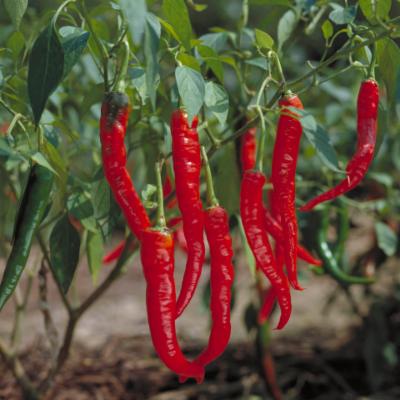Geography and distribution
Wild ancestors of Capsicum annuum evolved in Bolivia and southern Brazil, probably long before human habitation. Archaeological research estimates that they were first domesticated at least 6,100 years ago.
Numerous varieties were known to the Aztecs in Mexico before the Spanish arrived. Christopher Columbus brought seeds to Europe, and Capsicum annuum began to be planted extensively in Portuguese colonies in Africa, India and Asia. It is now grown around the world, both commercially and domestically.
Description
An attractive, upright shrub usually less than 1 m tall, with small, white, pendent flowers and elongated, yellow, orange or red fruits (berries). It can be distinguished from other types of domesticated peppers by flowers that are solitary rather than in groups, and filaments (thread-like stalks supporting the anther) that are not purple.
Capsicum annuum can be difficult to separate from the cultivated C. chinense (the hottest pepper) and C. frutescens (Tabasco pepper) and their morphological features can overlap. These three species share the same ancestral gene pool and are sometimes called the 'annuum-chinense-frutescens complex'.
The varieties and cultivars of Capsicum annuum are classified on the basis of their fruit shapes. There are so many different kinds (several thousand) that nobody knows exactly how many there are. More and more local variants are appearing in cultivation across the world because existing varieties cross-pollinate easily.
Uses - fruits
Capsicum fruits have been part of the human diet for at least 10,000 years. The fruits of non-pungent (sweet) varieties are eaten raw in salads or cooked as a vegetable. They are rich sources of vitamin C (ascorbic acid) and vitamin A.
Pungent types, including chillies, are used as a condiment or spice for seasoning. The dried fruits are ground to a powder (paprika) and used as an ingredient in curry powder. The pungency is mainly due to the presence of chemical compounds called capsaicinoids, which deter most mammals from eating the fruit. Birds, however, will eat them without harm (and indeed help to disperse the seeds).
Uses - pepper extracts
Pepper extracts are used to flavour ginger beer, and are used in pharmaceutical products for treating conditions such as athlete's foot and arthritis. Maya Indians used pepper spray as a weapon against their enemies, and today some police forces around the world use it to control unruly individuals.
Uses - decorations
Ornamental varieties of Capsicum annuum (the fruits of which are also edible) are grown primarily for the decorative value of their fruit, often displaying fruits of four or five colours simultaneously on one plant. The popular 'Christmas peppers' were originally available at Christmas time and had green and red fruits.
How hot is a 'chilli'?
In 1912, a pharmacist named Scoville developed an index for measuring the pungency of peppers. Scoville Heat Units (SHU) are still used today and measure by how much a chilli extract has to be diluted in sugar syrup before its heat becomes undetectable to a panel of expert tasters.
Sweet (or bell) peppers rank at 0 SHU, while New Mexico green chillies are mildly pungent at 1,500 SHU. The 'hottest' of the world's chillies exceed 80,000 SHU, but even they are relatively mild compared to the hottest of them all (the 'infinity chilli'), which registers over 1,000,000 SHU. Imagine that next time you have a curry!
Millennium Seed Bank - Saving seeds
The Millennium Seed Bank Partnership aims to save plant life worldwide, focusing on plants under threat and those of most use in the future. Seeds are dried, packaged and stored at a sub-zero temperature in our seed bank vault.
There are two collections of Capsicum annuum seeds stored in Kew's Millennium Seed Bank based at Wakehurst in West Sussex.
This species at Kew
Specimens of the fruits and seeds of Capsicum annuum are held in Kew's Economic Botany Collection in the Sir Joseph Banks Building and are available to researchers by appointment.






















